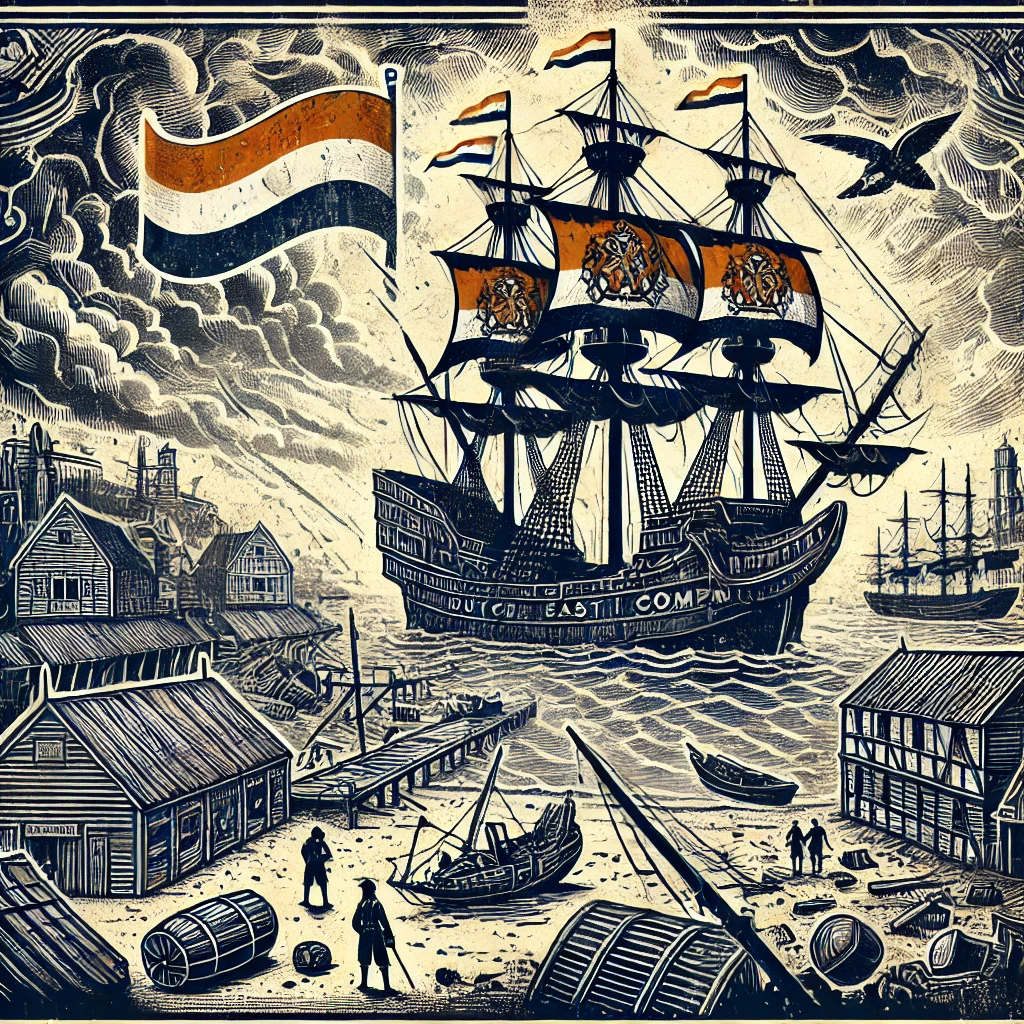Part 3: The Decline of the Dutch East India Company – From Empire to Ruin
Witness the downfall of the Dutch East India Company as corruption, financial mismanagement, and competitive pressures led to the collapse of a once-mighty trade empire. This final part examines the factors that contributed to the VOC’s decline and its lasting legacy on global commerce.
Table of Contents
The Beginning of the End
By the 18th century, cracks in the VOC’s empire had begun to deepen. The sprawling network of forts, outposts, and trade routes required massive resources to maintain, and the VOC’s relentless expansion had stretched its finances thin. Profits were dwindling, and corruption within the company only exacerbated the problem. Directors and officials continued to enrich themselves at the company’s expense, leading to inefficiency and mismanagement across VOC territories. The VOC’s initial success was largely built on its monopoly over the spice trade, but as the global economy evolved, so did its demands. Spices, once the “gold” of the East, were no longer as profitable as they once were, with prices dropping due to increased supply. Meanwhile, European consumers were becoming more interested in other goods, like tea, coffee, silk, and porcelain. Competitors like the British East India Company adapted to these shifts more readily, focusing on the broader trade of commodities, while the VOC struggled to pivot.
Battles on Multiple Fronts
As its monopoly waned, the VOC found itself battling not only rival companies but also political shifts back in Europe. The Dutch Republic, once a major power, was beginning to decline, and its support for the VOC weakened. Moreover, the ongoing conflicts in Europe, including the War of Spanish Succession (1701-1714), diverted resources and attention away from overseas ventures. The VOC’s directors, who had once enjoyed the full backing of the Dutch government, now faced increasing scrutiny as economic woes mounted. Externally, the VOC faced threats from both local rebellions and European rivals. Indigenous leaders who had been coerced into unfavorable contracts began to resist, seeking to reclaim control over their lands and resources. The VOC’s once-feared military force was spread thin, and uprisings became more frequent. In the late 18th century, a series of revolts across the East Indies dealt significant blows to the company’s stability. The British East India Company also became a formidable opponent, particularly in India, where it established control over major ports and trade networks. The British gradually took over territories in South and Southeast Asia, threatening the VOC’s dominance. In 1780, the outbreak of the Fourth Anglo-Dutch War further weakened the Dutch economy and the VOC’s grip on its colonies, as the British attacked and captured VOC outposts.
Financial Ruin and Government Intervention
By the 1770s, the VOC was teetering on the brink of bankruptcy. The company’s debts were spiraling out of control, and attempts to reform the organization failed. In 1796, the Dutch government finally stepped in, taking over the company’s debts and assets in an attempt to stabilize its finances. But it was too little, too late. By then, the VOC was beyond saving, its legacy overshadowed by corruption, debt, and an inability to adapt to changing economic realities. In 1799, after nearly two centuries of rule, the VOC was officially dissolved. Its assets and territories were taken over by the Dutch government, marking the end of an era. The VOC’s fall wasn’t just the end of a company—it was the end of a corporate empire that had wielded sovereign power over vast lands and resources.
The Lasting Legacy
Though the VOC no longer exists, its impact can still be felt today. The company left a profound mark on the Netherlands, Southeast Asia, and the global economy. In the Netherlands, the wealth generated by the VOC funded public works, cultural institutions, and the arts, contributing to the Dutch Golden Age. Amsterdam, in particular, became a hub of wealth and innovation, thanks in large part to VOC profits. In Southeast Asia, the VOC’s legacy is more complex. Its brutal tactics and exploitative practices left scars on the local communities it ruled. Traditional systems of governance were disrupted, indigenous leaders were marginalized, and local economies were often redirected solely to serve European markets. The VOC’s forced cultivation policies had lasting economic effects, some of which can still be seen in the agricultural landscapes of Indonesia. The VOC also set a precedent for the modern corporation. It was the first company to issue shares, establishing the model for public investment and limited liability that defines corporations today. Its global reach demonstrated the potential for businesses to wield power across borders, influencing politics, culture, and economies. But the VOC’s story is also a cautionary tale about the dangers of unchecked corporate power and the consequences of prioritizing profits over ethics.
Corporate Shoguns of the Early Modern Era
The VOC’s journey—from a group of merchants to a shadow sovereign ruling distant lands—embodied the essence of a corporate shogun. The company showed how a business, given enough autonomy, could function like a state, shaping the fate of entire regions. Its rise and fall illustrate both the potential and perils of corporate power, a theme that echoes through history and remains relevant in today’s globalized world. As one of history’s first corporate empires, the VOC paved the way for future multinational corporations, showing that influence doesn’t require a crown or an army—it only requires the ability to control resources, shape markets, and wield economic power with precision. The VOC’s story serves as a powerful reminder of the fine line between enterprise and empire, a line that future corporate shoguns would continue to explore and, at times, exploit. The story of the Dutch East India Company is more than a tale of trade and conquest. It’s a story of ambition, innovation, and the darker side of capitalism. The VOC was both a pioneer and a tyrant, a symbol of Dutch ingenuity and a testament to the dangers of unchecked power. Its legacy endures, reminding us that corporate shoguns have shaped—and continue to shape—the world in ways both inspiring and unsettling.
References
-
Dutch East India Company by Encyclopaedia Britannica
An authoritative account of the VOC’s historical significance. Britannica
-
The Embarrassment of Riches: An Interpretation of Dutch Culture in the Golden Age by Simon Schama
Examines Dutch culture during the VOC’s peak influence. Vintage
-
An Economic and Social History of the Netherlands, 1800–1920 by Michael Wintle
The Netherlands’ transition post-VOC. Cambridge University Press

